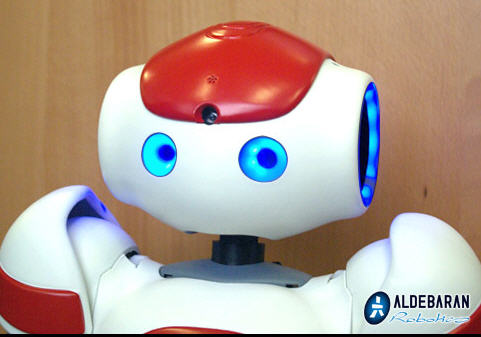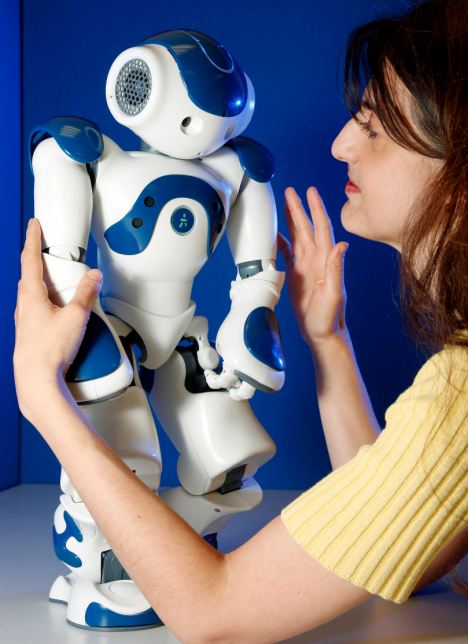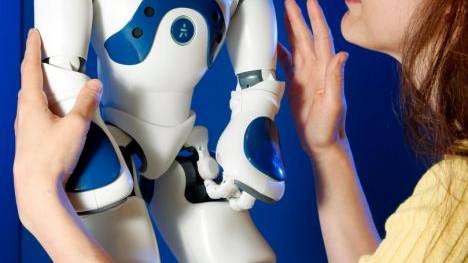First robot able to develop and show emotions is unveiled
Source: guardian.co.uk

Nao, developed by a European research team, models the first years of life and can form bonds with the people he meets
When Nao is sad, he hunches his shoulders forward and looks down. When he’s happy, he raises his arms, angling for a hug. When frightened, Naohe cowers, and he stays like that until he is soothed with some gentle strokes on his head.
Nothing out of the ordinary, perhaps, except that Nao is a robot — the world’s first that can develop and display emotions. He can form bonds with the people he meets depending on how he is treated. The more he interacts with someone, the more Nao learns a person’s moods and the stronger the bonds become.
"We’re modelling the first years of life," said Lola Cañamero, a computer scientist at the University of Hertforshire who led the project to create Nao’s emotions. "We are working on non-verbal cues and the emotions are revealed through physical postures, gestures and movements of the body rather than facial or verbal expression."

University of Hertfordshire researcher Dr Lola Canamero with Nao,
a robot that can show its emotions and form a bond with humans.
In future, say the scientists, robots are likely to act as companions or integrate with the web to order groceries online. They could also provide support for the elderly. In these uses some form of emotional display will be important in making those interactions more natural and more comfortable, Cañamero said.
Nao Robot
Video from: YouTube.com
While Japanese researchers have led advances in robot engineering, many European roboticists have instead focused on studying how robots will interact with humans. Kerstin Dautenhahn, a professor of artificial intelligence at the University of Hertfordshire, has developed Kaspar, a robot in the shape of a two-year-old boy, which can make facial expressions and play games such as peek-a-boo. She has also set up a flat in Hatfield, where a home-help robot interacts with volunteers, to study longer-term relationships between people and machines.
Nao has been programmed to mimic the emotional skills of a one-year-old child, learning and interpreting specific cues from humans and responding accordingly. He can use video cameras to work out how close a person comes and sensors to detect how tactile they are. "If you want to tell the robot it’s doing well, you might show your face or smile or you might pat them on the head," said Cañamero.
Nao can also work out where his human companions are looking, follow their gaze and memorise different people’s faces. Using a neural network brain, he can remember interactions with different people. This understanding, plus some basic rules of what is good and bad for him learned from exploring his environment, allows Nao to indicate whether he is happy, sad or frightened with what is going on around him. The display actions for each emotion are pre-programmed but Nao decides by himself when to display each emotion or combination of emotions.
"Those responses make a huge difference for people to be able to interact naturally with a robot," said Cañamero. If people can behave naturally around their robot companions, robots will be better-accepted as they become more common in our lives, she said.
Nao can also be programmed to have different personalities. A more independent robot is less likely to call for human help when exploring a room, whereas a more needy and fearful robot will display distress if it finds something in the room that it knows is potentially harmful or unknown.
Chimpanzees, which provided much of the data for the emotional responses Cañamero used in her work, have already benefited from some of the work that has gone into programming emotional robots. "Lots of them live in sanctuaries and research institutes and they’re miserable," said Cañamero. "They’re living in enclosures and they behave in non-natural ways. They enjoy interacting with robots. One of our colleagues put a robot outside the enclosures and the chimpanzees went to fetch their friends to look, and they got excited and motivated to move around."
Nao’s programming was developed as part of a project called Feelix Growing, funded by the European commission. It was a collaboration of eight universities and robotics companies across the UK, France, Switzerland, Greece and Denmark.
Other members of the project have used robots, each programmed with different emotional "personalities", with autistic children to study the kinds of social partner which are best for these children to learn social skills.
Cañamero’s team will take its emotional programming forward into medical applications as part of a new commission-funded project called Aliz-E, which will be co-ordinated by Tony Belpaeme, a researcher in cognitive robotics at the University of Plymouth. Part of that project will look at ways to use robots such as Nao in hospitals, to support the roles of doctors, nurses and parents.
Cañamero said that children might find that a small, friendly-looking robot that can understand their emotional state could make them less anxious when it comes to preparing for medical treatment. "We want to explore different roles – the robots will help the children to understand their treatment, explain what they have to do. We want to help the children to control their anxiety," she said.
Article from: guardian.co.uk






















